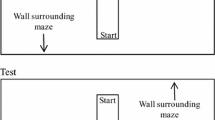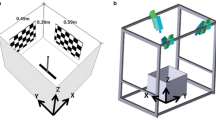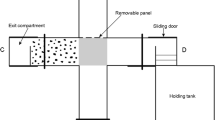Summary
The wandering spider Cupiennius salei Keys uses idiothetic orientation, i.e., memorized information about its own previous movements, to retrieve lost prey. Spiders, having been chased away from a prey fly, return to the capture site (the goal) over a distance of more than 75 cm even though all external orientation cues were precluded. This behavior and its sensory basis were examined by varying the proprioceptive and ‘motor command’ inputs to the memory and by ablating particular lyriform slit sense organs on the legs of the spider.
The success rate of returns to the goal after rectilinear chases over 6 discrete distances ranging from 20 cm to>41 cm declines with increasing distances. At distances>41 cm, more than 50% of the performances of intact spiders are nevertheless ‘successful’, in that the animals approach the capture site as close as 5 cm (or less).
Animals that have been operated on (lyriform organs on all femora destroyed) are much less successful even at short distances. The mean starting angles of the returns by intact spiders and by those operated on do not differ signficantly. ‘Walking error e n’ for each segment of the entire return path shows that intact animals deviate little from the ideal return route and correctly estimate the distance to the goal. The operated spiders tend to drift off the ideal return route, while their distance estimates remain largely accurate.
Returns after curvilinear chases through a semicircular corridor do not retrace the curved path; instead the spiders take a shortcut. Of all performances by intact and by control spiders (with sham operations) 85% are successful. By contrast, most of the 8 groups with sensory ablations have a success rate of less than 50%.
Compensation for the semicircular detours is not quite complete: the mean starting directions of returns are biased, pointing to the corridor, and the shape of many return paths reflects the curved corridor shape. Spiders with unilateral ablations of their femoral lyriform organs show low success rates only if the operated legs are on the inner curve perimeter during the chase, while their return parameters resemble those of the intact group in the reverse situation (operated legs on outer perimeter). These side-specific ablation effects, which are correlated with the geometrical situation existing while idiothetic information is gathered and memorized, suggest that the idiothetic memory depends at least partly on input from proprioceptors.
Similar content being viewed by others
References
Barth FG, Libera W (1970) Ein Atlas der Spaltsinnesorgane von Cupiennius salei Keys. Chelicerata (Araneae). Z Morphol Tiere 68:343–369
Barth FG, Seyfarth E-A (1971) Slit sense organs and kinesthetic orientation. Z Vergl Physiol 74:326–328
Barth FG, Seyfarth E-A (1979) Cupiennius salei Keys. (Araneae) in the highlands of Central Guatemala. J Arachnol 7:255–263
Batschelet E (1965) Statistical methods for the analysis of problems in animal orientation and certain biological rhythms. American Institute of Biological Science, Washington, DC
Dornfeldt K (1975) Eine Elementaranalyse des Wirkungsgefüges des Heimfindevermögens der Trichterspinne Agelena labyrinthica (Cl.). Z Tierpsychol 38:267–293
Görner P (1958) Die optische und kinästhetische Orientierung der Trichterspinne Agelena labyrinthica (Cl.) Z Vergl Physiol 41:111–153
Görner P (1973) Beispiele einer Orientierung ohne richtende Außenreize. Fortschr Zool 21:20–45
Görner P, Zeppenfeld Ch (1980) The runs of Pardosa amentata (Araneae, Lycosidae) after removing its cocoon. Proc Int Congr Arachnol 8:243–248
Hagen H-O v (1967) Nachweis einer kinästhetischen Orienticrung bei Ucarapax. Z Morphol Ökol Tiere 58:301–320
Jander P (1970) Ein Ansatz zur modernen Elementarbeschreibung der Orientierungshandlung. Z Tierpsychol 27:771–778
Melchers M (1963) Zur Biologie und zum Verhalten von Cupiennius salei (Keyserling), einer amerikanischen Ctenide. Zool Jahrb Abt Sys Ökol Geogr Tiere 91:1–90
Mittelstaedt H (1978) Kybernetische Analyse von Orientierungsleistungen. In: Hauske G, Butenandt E (eds) Kybernetik '77. Oldenbourg, München Wien, pp 144–195
Mittelstaedt H, Mittelstaedt M-L (1973) Mechanismen der Orientierung ohne richtende Außenreize. fortschr Zool 21:46–58
Mittelstaedt M-L, Mittelstaedt H (1980) Homing by path integration in a mammal. Naturwissenschaften 67:566
Rovner JS, Knost SJ (1974) Post-immobilization wrapping of prey by lycosid spiders of the herbaceous stratum. Psyche 81:398–415
Seyfarth E-A (1980) Daily patterns of locomotor activity in a wandering spider. Physiol Entomol 5:199–206
Seyfarth E-A, Barth FG (1972) Compound slit sense organs on the spider leg: Mechanoreceptors involved in kinesthetic orientation. J Comp Physiol 78:176–191
Seyfarth E-A, Bohnenberger J (1980) Compensated walking of tarantula spiders and the effect of lyriform slit sense organ ablation. Proc Int Congr Arachnol 8:249–255
Author information
Authors and Affiliations
Rights and permissions
About this article
Cite this article
Seyfarth, EA., Hergenröder, R., Ebbes, H. et al. Idiothetic orientation of a wandering spider: Compensation of detours and estimates of goal distance. Behav Ecol Sociobiol 11, 139–148 (1982). https://doi.org/10.1007/BF00300103
Received:
Accepted:
Issue Date:
DOI: https://doi.org/10.1007/BF00300103




